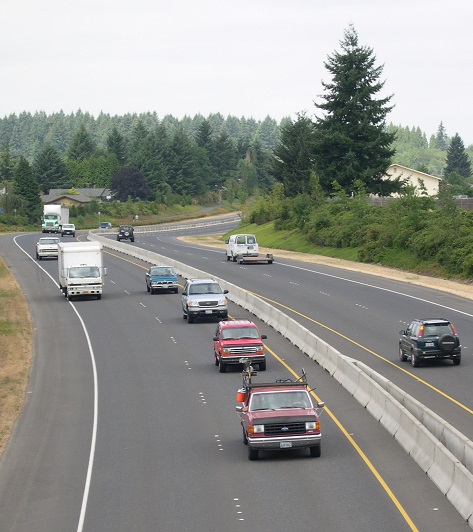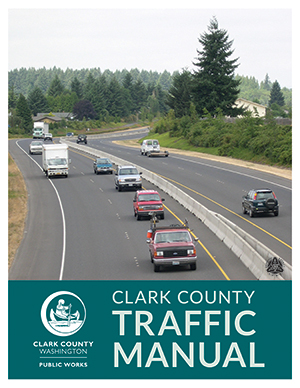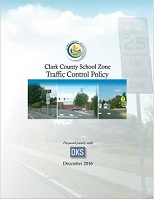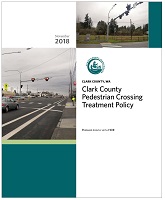As Clark County’s population continues to grow toward a half million people, increasing emphasis is placed on managing traffic to safely and efficiently move people and goods.
Public Works often receives requests to have traffic engineers examine a traffic concern on a particular street or location. County residents who want to report a traffic concern should fill out an online request.
Clark County manages traffic only in unincorporated areas outside city limits.
In addition, the county does not manage traffic on federal freeways or state highways, such as Interstate 5 and State Route 500, or on private roads.
Traffic counts
Public Works collects 24-hour counts of vehicles throughout the year on a variety of county streets and roads.
Clark County's interactive MapsOnline can provide the most recent traffic counts, including location, traffic count date and vehicles per traffic direction.
Traffic counts are typically taken on Tuesday, Wednesday or Thursday. Traffic volumes can vary due to seasonal fluctuations, construction, weather, crashes and other factors.
Follow these steps to review traffic counts:
- Open MapsOnline.
- In the left-hand column, click the box to the left of "Traffic Counts" (in bold font about midway in the menu).
- On the left-hand column, click the "+" sign to the left of "Traffic Counts."
- Click on the "i" in a circle immediately to the left of "Segment Counts."
- Find your location on the map, using the "+/-" feature in the bottom right corner to zoom in or out as needed, and look for an orange circle indicating a traffic count location.
- Click on the orange circle for traffic count data for that location.
Traffic signals
Public Works uses emerging technologies to get better performance out of traffic signals, which reduces congestion, greenhouse gas emissions and driver frustration.
Learn more about Clark County’s comprehensive signal program on the traffic signals webpage.
In addition, review the Federal Highway Administration's case study of the Clark County's automated traffic signals performance measures.
Traffic cameras
Clark County has nearly 100 cameras at signalized intersections, primarily in the urban area outside the city of Vancouver.
County residents may find it helpful to review images from these cameras during morning and afternoon rush hour or inclement weather to determine the best route to their destinations.
For more information, visit the department’s traffic cameras webpage.
Traffic manual
The Clark County Traffic Manual provides guidelines for the application of traffic control devices. The purpose of this manual is to attain uniformity in the application of traffic control devices, which enhances the safety and operations along county roads.
This manual is based on national best practices, research from accredited publications, consultation with other agencies, sound engineering judgment, and input from field maintenance staff. It does not supersede the Manual on Uniform Traffic Control Devices, or any other established Federal, State, or local guidelines, but rather provides clarification for unique situations.
School zones
Public Works has a policy for traffic control near public and private schools.
The policy is intended to provide guidelines for uniform, consistent traffic control in school zones, including reduced speed zones, signage and beacons, pedestrian crossings and pavement markings.
Clark County, in partnership with DKS Associates, developed this policy based on the Manual on Uniform Traffic Control Devices, Washington state law and sound engineering practice.
Clark County School Zone Traffic Control Policy (PDF)
Clark County School Zone Flyer (PDF)
Pedestrian crossings
Public Works, as part of its commitment to multimodal transportation and walkable communities, has developed a detailed policy and prioritization for pedestrian crossings on county roads.
The Clark County Pedestrian Crossing Treatment Policy provides guidelines for deciding what type of pedestrian crossing is most suitable for a particular location.
The policy defines “trigger points” to determine appropriate crossing features and how the crossing would best enhance pedestrian safety and mobility.
The Clark County Pedestrian Crossing Prioritization Program provides an equitable and objective criteria to prioritize potential pedestrian crossings based on the following criteria:
- Demand (Demographic and Land Use): sociodemographic and land use factors
- Connectivity/Accessibility: existing sidewalks, trail crossings, or transit access
- Safety (Crossing Risk): roadway traffic volume and speed, number of lanes to be crossed
- Safety (Crash History): number of crashes and severity of crash
Clark County Pedestrian Crossing Treatment Policy (PDF)
Clark County Pedestrian Crossing Flyer (PDF)
Clark County Pedestrian Crossing Prioritization Program (PDF)
Speeding
Public Works also does not enforce speed laws or issue traffic and parking citations. Residents who want information about enforcement should contact the Clark County Sheriff’s Office or call the non-emergency: 311. Abandoned vehicles can be reported through CRESA's online abandoned vehicle form.
Public Works does examine traffic speeds and volumes on specific streets. County residents who want to report a traffic concern should fill out an online request.
Neighborhood traffic
Public Works typically does not build speed humps to slow, or “calm,” traffic in neighborhoods. Speed humps are inherently divisive and often pit neighbor against neighbor.
Parking
Do you have questions about parking, especially in residential areas? Visit the department’s parking webpage for information about restrictions outlined in Washington state law and Clark County Code.



